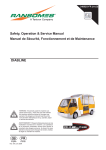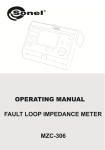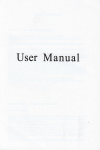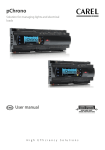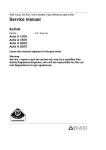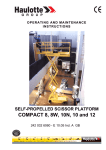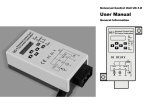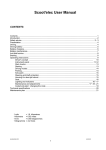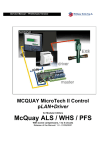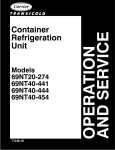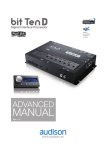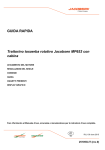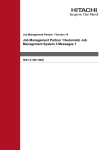Download Safety, Operation & Service Manual DIABLINE
Transcript
24882G-GB (rev.0) Safety, Operation & Service Manual DIABLINE WARNING: If incorrectly used this machine can cause severe injury. Those who use and maintain this machine should be trained in its proper use, warned of its dangers and should read the entire manual before attempting to set up, operate, adjust or service the machine. RJL 100 June 2009 WARNING DO NOT USE THIS VEHICLE UNLESS YOU HAVE BEEN TRAINED IN ITS USE AND SAFETY. TRAINING CONSISTS OF KNOWLEDGE OF THE WORK REGULATIONS OF YOUR EMPLOYER, INSTRUCTIONS IN THIS MANUAL AND THE CURRENT REGULATIONS FOR THIS TYPE OF MACHINE. A NON-QUALIFIED OPERATOR IS EXPOSED TO AND EXPOSES OTHERS TO THE RISK OF SERIOUS INJURY. © 2009, Ransomes Jacobsen Limited. All Rights Reserved RANSOMES DIABLINE SAFETY AND OPERATORS MANUAL TABLE OF CONTENTS A.1 INTRODUCTION .............................................................................. 9 A.2 A.2.1 A.2.2 GENERAL DESCRIPTION DESCRIPTION OF THE VEHICLE ................................................. 11 DIMENSIONS AND TECHNICAL CHARACTERISTICS ................. 12 A.3 A.3.1 A.3.1.1 A.3.1.2 A.3.2 A.3.3 A.3.3.1 A.3.3.2 SAFETY ADVICE GENERAL ....................................................................................... 14 INFORMATION FOR THE DRIVER ................................................ 14 QUALIFICATIONS OF THE DRIVER ............................................. 15 BASIC RULES ................................................................................ 16 SERVICING..................................................................................... 17 LUBRICATION ................................................................................ 18 BATTERIES..................................................................................... 18 A.4 A.4.1 A.4.2 A.4.3 A.4.4 A.4.5 A.4.6 A.4.7 A.4.8 A.4.9 A.4.10 A.4.11 A.4.12 A.4.13 A.4.14 A.4.15 A.4.16 A.4.17 A.4.18 VEHICLE CONTROLS DRIVING POSITION ....................................................................... 19 STARTER KEY................................................................................ 20 FORWARD-REVERSE CONTROL ................................................. 20 STEERING WHEEL ........................................................................ 20 BRAKE PEDAL ............................................................................... 20 ACCELERATOR PEDAL ................................................................. 21 PARKING BRAKE ........................................................................... 21 EMERGENCY STOP ...................................................................... 21 AUDIBLE ALARM (HORN).............................................................. 22 LIGHTING ....................................................................................... 22 INDICATORS .................................................................................. 22 WINDSCREEN WIPER ................................................................... 22 WINDSCREEN WASHER ............................................................... 22 WINDSCREEN DE-ICER / HEATER............................................... 22 M.D.I. INDICATOR ......................................................................... 23 FUSES ............................................................................................ 25 HYDRAULIC DUMP TRUCK CONTROL (D24) .............................. 26 SPECIAL OPERATIONS ................................................................. 26 A.5 A.5.1 A.5.1.1 A.5.1.2 A.5.1.3 A.5.2 A.5.2.1 A.5.2.2 A.5.2.3 A.5.2.4 A.5.2.5 A.5.2.7 PROCEDURES FOR USE CHECKS BEFORE USE ................................................................. 27 CONTROLS .................................................................................... 27 SAFETY EQUIPMENT .................................................................... 27 LIGHTING AND SIGNALLING ........................................................ 27 ADVICE ON USE ............................................................................ 27 DRIVING ......................................................................................... 27 LOADING AND UNLOADING ......................................................... 27 STARTING PROCEDURE ............................................................. 27 STOP PROCEDURE....................................................................... 27 EMERGENCY STOP ..................................................................... 28 CHARGE OF BATTERIES .............................................................. 30 A.6 INSTRUCTIONS FOR TRANSPORTING ....................................... 31 GB-3 RANSOMES DIABLINE SAFETY AND OPERATORS MANUAL GB-4 A.7 TYRES ............................................................................................ 32 B.1 B.1.1 B.1.2 B.1.3 B.1.4 B.1.5 B.1.6 B.1.7 B.1.8 B.1.9 B.1.10 B.1.11 B.1.12 GENERAL MAINTENANCE GENERAL ....................................................................................... 34 CLEANLINESS ............................................................................... 34 REMOVAL AND REFITTING........................................................... 35 PROCEDURE ................................................................................. 35 BATTERIES..................................................................................... 35 BATTERIES CENTRAL FILLING .................................................... 36 SIMPLE STEPS FOR LONGER BATTERY LIFE............................ 37 ELECTRIC WIRES AND CABLES .................................................. 41 ELECTRIC MOTOR ........................................................................ 41 BEARINGS..................................................................................... 42 NUTS AND BOLTS.......................................................................... 42 WATERPROOFING ........................................................................ 42 B.2 B.2.1 B.2.2 B.2.3 B.2.4 B.2.5 B.2.6 B.2.7 B.2.8 SERVICING WASHING THE VEHICLE............................................................... 43 LUBRICATION POINTS ................................................................. 44 SUSPENSION PRESSURE ............................................................ 46 STEERING ...................................................................................... 47 BRAKE FLUID................................................................................. 47 CHARGER ...................................................................................... 48 MAINTENANCE SCHEDULE ......................................................... 49 BREAKDOWN GUIDE .................................................................... 50 B.3 B.3.1 B.3.2 ELECTRICAL DIAGRAM ELECTRICAL DIAGRAM STANDARD ............................................ 51 ELECTRICAL DIAGRAM WITH GAS GENERATOR ...................... 52 RANSOMES DIABLINE SAFETY AND OPERATORS MANUAL NEW PRODUCT WARRANTY The seller guarantees each new product against all material or manufacturing fault, without obligation, his responsibility being limited under this guarantee to the repair or replacement of each part recognised as being defective in use or normal maintenance, and the reasonable cost of repair and or replacement of the said parts during the twelve months from the initial date of purchase, hire purchase or rental, on the understanding that the taking into service of the equipment has been registered with the seller. In the case that the equipment has not been registered with the seller, the initial date of sale, of hire purchase or of rental will be the date of despatch from the factory. This warranty replaces all other guarantees explicit or implicit and the responsibility of the seller under this guarantee excludes the cost of transport or others or all responsibility for damage, direct or indirect or consecutive such as all delays due to possible faults. The warranty will be null and void in the case of use over capacity or in conditions not foreseen by the seller or in the case of use of parts not recognised by the said seller. NOTES To obtain a copy of the terms and conditions of the application of the warranty, call or write to Ransomes Jacobsen Limited. The use of parts not originating from Ransomes Jacobsen Limited can result in the cancellation of this warranty. The charging of the batteries by a means other than the fitted charger will result in the cancellation of the warranty. FOR THE ATTENTION OF THE CLIENT / USER If this vehicle is involved in an accident, please contact your distributor immediately and provide him with all the details of the accident in order that he may notify the firm. If the distributor is unknown or cannot be notified, please contact: Ransomes Jacobsen Limited West Road, Ransomes Europark, Ipswich IP3 9TT, England Tel: +44 (0) 1473 270000 Fax: +44 (0) 1473 276300 www.ransomesjacobsen.com GB-5 RANSOMES DIABLINE SAFETY AND OPERATORS MANUAL FOREWORD This manual has been prepared in order to allow you to correctly use and service your electric vehicle. Before putting the vehicle into service, take the time to carefully read and familiarise yourself with the contents of this manual. After having read and understood all the sections, keep the manual in its place. This vehicle has been designed to offer maximum performance with minimum servicing. The proper employment of the servicing operations ensures years of use without problems. With our policy of continuous improvement of our products, we reserve the right to make changes without warning to the specifications and equipment. The servicing procedures and routines are given in this manual with each machine and must be consulted for detailed information. Information in this manual in no case replaces internal regulations, advice or insurance policy clauses. This manual consists of the following main parts: Section A: SAFETY AND USE This part covers the safety of personnel in relation to: • conditions of use of the vehicle • the functioning of the vehicle • the vehicle itself Section B: GENERAL MAINTENANCE AND UPKEEP This part aims to assist you to keep to the basic rules of , to maintain your vehicle and to detect possible breakdowns. GB-6 RANSOMES DIABLINE SAFETY AND OPERATORS MANUAL The definitions DANGER, ATTENTION, and NOTE in this manual are the following: DANGER - Indicates an imminently hazardous situation which, if not avoided, WILL result in death or serious injury. WARNING - Indicates a potentially hazardous situation which, if not avoided, COULD result in death or serious injury. CAUTION - Indicates a potentially hazardous situation which, if not avoided, MAY result in minor or moderate injury and property damage. It may also be used to alert against unsafe practices. GB-7 RANSOMES DIABLINE SAFETY AND OPERATORS MANUAL Section A SAFETY AND USE GB-8 RANSOMES DIABLINE SAFETY AND OPERATORS MANUAL A.1 INTRODUCTION This manual contains all-important information relative to the functions and maintenance of the Ransomes Diabline model electric vehicles. This vehicle is an automotive type with a chassis in steel and aluminium. Power is by electric motor situated on the rear axle. Batteries provide electric power. The driving position is on the front left of the vehicle. The nominal capacity of the machine is indicated on the plate displaying the permissible loads situated on left of the driver seat. This stipulated load must not be exceeded. ON DELIVERY… You must immediately check your vehicle on delivery in order to ensure that nothing has been forgotten or appears to have deteriorated. Checking of the vehicle Examine the vehicle such as the accessories delivered separately. Ensure that all that you have ordered has been delivered. Nothing must appear damaged or deteriorated. GB-9 RANSOMES DIABLINE SAFETY AND OPERATORS MANUAL Check the function of controls Carry out each of the following checks : • Accelerator pedal • Brake pedal • Forward/reverse switch • Brakes • Steering • Audible alarm • Lighting and indicators If you find a problem… Immediately draw up a list and send it to: Ransomes Jacobsen Limited West Road, Ransomes Europark, Ipswich IP3 9TT, England WARNING DO NOT REPAIR, MODIFY OR ADJUST A PART OF THE VEHICLE WITHOUT THE WRITTEN AGREEMENT OF RANSOMES JACOBSEN LIMITED, THIS WILL RESULT IN THE CANCELLATION OF THE WARRANTY. FURTHER AN INCORRECT REPAIR CAN CAUSE SERIOUS INJURY. GB-10 RANSOMES DIABLINE SAFETY AND OPERATORS MANUAL A.2 GENERAL DESCRIPTION A.2.1 Description of the vehicle Driving Position Batteries Steering Wheels Passanger Cabin Motor / Reducer Drive Wheels GB-11 RANSOMES DIABLINE SAFETY AND OPERATORS MANUAL A.2.2 Dimensions and technical characteristics Diabline side (mm) GB-12 A Wheelbase 2345 B Length 3790 C Front overhang 880 D Rear overhang 635 E Front track 1270 F Front width 1440 G Rear track 1310 H Rear width 1520 I Drivers Cabin height 1800 Passenger Cabin Height 2200 J Load deck sill height 290 K Modular Main deck height 750 L Lower deck length 1070 RANSOMES DIABLINE SAFETY AND OPERATORS MANUAL Motor Electric Volt 48 Wheels Number of driving wheels Rear deck length x width mm 2320 x 1450 Deck height height empty mm 750 Dimensions length mm 3790 width mm 1520 seat height mm 760 height with cabin mm 1800 m 4,25 2 AR Turning circle minimum between walls Road width for a turn of 90° mm 2700 Tow hook height centre in relation to ground mm 350 Weight empty without batteries kg 545 Tyres dimensions front 145/70/R13 dimensions rear 145/70/R13 Wheelbase mm 2345 Track from centre of tyre Front/rear mm 1270 / 1310 Height in relation to ground without load at the lowest point mm 150 without load at centre of wheelbase mm 165 Brakes Front + Rear hydraulic discs Brake assistance Rear electric Parking brake mechanical Suspension 4 wheel independent Electric motor power Electronic speed control Maximum power Batteries gel or lead/acid nominal voltage Tow bar patented system Batteries capacity (C/5) Batteries oleo pneumati kW Amp 6 400 monobloc or cells V 48 multi-arm Amp 205 275 weight kg 250 380 Range in realistic usage when empty km 40-60 55-80 Consumption average when empty Wh/km 160 160 Charger 220V fitted power on charge Amp 20 50 Useable load in standard platform version kg 625 495 Transmission mechanical by differential reduction Effort to the hook ratios 7 10 15 7 10 15 continuous service : 60’ on flat ground kg - 100 150 - 100 150 Max : 5’ on flat ground kg - 190 280 - 190 280 Admissible slope empty / loaded % 15/7 17/9 18/10 15/7 17/9 18/10 maximum speed empty km/h 58 48 35 58 48 35 GB-13 RANSOMES DIABLINE SAFETY AND OPERATORS MANUAL A.3 SAFETY ADVICE A.3.1 General It is impossible to establish a complete list of safety advice covering all situations. In the meantime, a certain number of basic rules MUST be followed in the course of the daily use of the vehicle. Safety is your FIRST RESPONSIBILITY, because the vehicle can only be PERFECTLY MASTERED by the user. WARNING FAILURE TO FOLLOW A SINGLE PIECE OF SAFETY ADVICE COULD RISK AN ACCIDENT TO THE VEHICLE AND INJURY TO THE PERSONNEL. YOU ARE RESPONSIBLE FOR YOUR SAFETY AND FOR THOSE PERSONNEL AROUND YOU. A.3.1.1 Information FOR THE DRIVER You must READ and ASSIMILATE the MANUAL FOR THE SAFETY OPERATOR before using the vehicle. This manual must be readily available at all times Ensure that all persons in the vehicle perfectly understand the safety procedures and apply them. You must know exactly the position of and the signs that appear on all the plates and stickers on the vehicle. You must know the regulations and standards applying to industrial vehicles and their use. Works practices can vary slightly according to national regulations, industry norms and employer regulations. It is for this reason that all the different norms must be well understood. GB-14 RANSOMES DIABLINE SAFETY AND OPERATORS MANUAL A.3.1.2 Qualifications OF THE DRIVER WARNING DO NOT USE THIS VEHICLE UNLESS YOU HAVE BEEN TRAINED IN ITS USE AND SAFETY. TRAINING CONSISTS OF KNOWLEDGE OF THE WORK REGULATIONS OF YOUR EMPLOYER, INSTRUCTIONS IN THIS MANUAL AND THE CURRENT REGULATIONS FOR THIS TYPE OF MACHINE. A NON-QUALIFIED OPERATOR IS EXPOSED TO AND EXPOSES OTHERS TO THE RISK OF SERIOUS INJURY. Do not try to use the vehicle if you do not have the training and the knowledge necessary for all the functions of the vehicle. The controls, characteristics and procedures may vary from one vehicle to another, this is why it is VITAL that the operator receives appropriate training and that it is given by competent and authorised personnel. You must be in perfect physical and mental health to use the vehicle and must not be under the influence of medicines, narcotics or alcohol. ALL types of drugs can reduce reactions and physical abilities, visual and mental. A qualified driver must be able to: • Master each vehicle control • Understand and abide by all the advice in this manual • Know how to correctly load and unload material • Know how to correctly park the vehicle • Recognise a badly serviced vehicle • Be able to control the vehicle in all situations GB-15 RANSOMES DIABLINE SAFETY AND OPERATORS MANUAL A.3.2 Basic rules Never put your safety at risk and that of others in trying to use a machine for something for which you have not been trained. It is VITAL that the operator has received adequate training and knows perfectly the regulations for the use of the vehicle: • Stay inside the vehicle during its movement. Do not leave an arm, a leg or the head outside the vehicle • Drive carefully • Do not turn the steering wheel violently when moving at high speed • Drive preferably on a flat surface or, if you have no other choice, on a surface with a slope that does not exceed 15% • Do not take the vehicle over holes or bumps or objects on the ground • Observe all the driving regulations and speed restrictions (60 km/h max) • Keep a safe distance between the vehicle and possible obstacles • Always keep full control of the vehicle • Warn personnel, by using the horn, when you approach a crossing or a corner of a wall behind which people or another vehicle may be approaching • Give priority to pedestrians, ambulances, firemen or all other emergency vehicles • Always keep an eye on others; anticipate their manoeuvres or their movements GB-16 RANSOMES DIABLINE SAFETY AND OPERATORS MANUAL A.3.3 Servicing WARNING IN THE ABSENCE OF PROPER MAINTENANCE AND CHECKING OF THIS VEHICLE, THERE IS A RISK OF SERIOUS INJURY. THIS VEHICLE MUST NOT BE USED IF IT IS NOT IN PERFECT WORKING ORDER. Always keep the vehicle clean. Eliminate all traces of mud, dirt or grease. Dirty equipment wears more and makes servicing difficult. Use only appropriate and nonflammable cleaning products. Avoid spraying directly on electrical components. Routine servicing and inspection of this vehicle must be carried out by a qualified person and according to the recommendations contained in the chapter «General maintenance and servicing». For all questions concerning procedures and specifications, speak to your Ransomes distributor. Except with the written authorisation and agreement of Ransomes Jacobsen Limited, no modification affecting the original design may be made to the vehicle. Such modifications render invalid the warranty and render the owner and/or user liable in the case of an accident. Before carrying out servicing or a repair on the vehicle: 1. The vehicle must be parked in a clean state and disengaged. The emergency stop button must be pressed, the parking brake locked and the forward-reverse switch in the neutral position. 2. The batteries must be disconnected, also the charger plug and the starter key removed After having carried out servicing or repair operations: 1. 2. 3. 4. Replace all covers that have been removed Reconnect the batteries Remove all chocks and or supports Carry out a functional test on all controls in order to ensure their proper functioning. If the brake parts have been removed, test the brakes before refilling with hydraulic fluid. Purge the circuit if necessary and check the level. Carry out the checks once more GB-17 RANSOMES DIABLINE SAFETY AND OPERATORS MANUAL A.3.3.1 Lubrication The vehicle must be lubricated and greased according to the constructor’s recommendation concerning the lubrication points, periods and types of products to be used. If your vehicle is not correctly greased, there is a risk of overheating of the mechanical parts, which can result in their deterioration. A.3.3.2 Batteries The battery electrolyte must never be brought into contact with the skin or the eyes. In case of accidental splashing, immediately and copiously wash the effected part with cold water and consult a doctor. During inspection and maintenance of the battery, abide by the precautions and procedures below: • Never check the state of charge of a battery by short-circuiting the connections. The sparks or flames can produce an explosion of the battery • Check the level of the electrolyte in the battery using the floats, generally green, in the centre of each refill cap. If the batteries are not equipped with this type of device, check that the level of water totally covers the plates. • Wear safety glasses for all work on the batteries • Never disconnect the positive cable of the battery first. On the contrary, disconnect the negative cable first. This must be reconnected last when replacing the battery. GB-18 RANSOMES DIABLINE SAFETY AND OPERATORS MANUAL A.4 VEHICLE CONTROLS A.4.1 Driving position This section describes the function and position of each control. It is vital that the driver familiarises himself with the use of the controls before using the vehicle (details follow): Driving lights warning light MDI indicator Lighting & horn switch Ventilation grills Analog speedometer Windscreen wiper switch Brake pedal Accelerator pedal Change Time/ Kilometre Keyswitch Check MDI Direction warning lights Direction control button Hazard flasher switch Heating/ demisting Optional generator starter switch GB-19 RANSOMES DIABLINE SAFETY AND OPERATORS MANUAL Handbrake Emergency stop Forward/ back control for seat A.4.2 Starter key The Neiman anti theft/starter key is situated on the right hand side of the dashboard and activates the electrical functions of the vehicle. Turn the key in a clockwise direction to switch on the vehicle (I), turn the key in an anticlockwise direction to turn off the electricity (0). WARNING THE STARTER KEY MUST BE IN THE 0 POSITION EACH TIME THE DRIVER LEAVES THE VEHICLE NOTE THE STARTER KEY CAN ONLY BE WITHDRAWN WHEN IT IS IN THE 0 POSITION. NOTE CERTAIN CONTROLS ARE OPTIONAL. A.4.3 Forward-Reverse control This is a 3-position switch. It is situated to the right of the dashboard and establishes the direction of travel of the vehicle. A.4.4 Steering wheel The steering wheel is attached to a column of the same type as a touring car. Turn the wheel to the right to direct the wheels to the right and turn the wheel to the left to direct the wheels to the left. A.4.5 Brake pedal The brake pedal is situated to the right of the steering column. It must be operated only with the right foot. This pedal works, by fluid, on pistons that push the brake pads onto a steel disc. The more you push on the pedal, the more you brake the vehicle. NOTE WHEN THE PEDAL IS ACTIVATED SO ARE THE BRAKE LIGHTS ON THE BACK OF THE VEHICLE. GB-20 RANSOMES DIABLINE SAFETY AND OPERATORS MANUAL A.4.6 Accelerator pedal The accelerator pedal is situated to the right of the brake pedal. It must be operated only with the right foot. This pedal controls the speed of the vehicle using a potentiometer. The more you push on the pedal, the more you accelerate the vehicle. When the accelerator pedal is fully raised a regenerative braking system slows the vehicle . NOTE THE BRAKE PEDAL MUST BE USED TO EFFICIENTLY BRAKE THE VEHICLE. A.4.7 Parking brake The parking brake lever is situated between the two seats. NOTE THE PARKING BRAKE MUST ALWAYS BE PROPERLY ADJUSTED. A.4.8 Emergency stop The emergency stop button, usually coloured red, is situated between the driver and the passenger seats. In case of emergency, this cuts off the electrical power. Push on the button to cut the supply and pull the button to re-establish power. GB-21 RANSOMES DIABLINE SAFETY AND OPERATORS MANUAL A.4.9 Audible alarm (Horn) It is situated at the end of the left control lever, on the left side of the steering column. Push on the button to warn then release. An audible safety-warning signal sounds when the vehicle moves in reverse. When reverse is engaged, the buzzer sounds to warn personnel that the vehicle is reversing. A.4.10 Lighting The lighting switch is situated on the left control lever. When it is actuated the headlights on the front of the vehicle are switched on as well as the rear lights. Turn the switch one click to switch on the sidelights, and turn two clicks to switch on the main lights. Pull the lever upward for Full beam. Turn the switch to position 0 to switch everything off. A.4.11 Indicators Please signal all changes of direction, left and right, using the left switch lever. Push the lever forwards to indicate a change of direction to the right and pull the lever towards the rear to signal a change to the left. A.4.12 Windscreen wiper This is the right hand switch lever. Pull the lever towards the rear to activate the wiper blade in single sweeps. Push the lever towards the front one click to activate the wiper blade with interrupted sweeps, and push two or three clicks to activate in slow and rapid continuous sweeps. A.4.13 Windscreen washer This is the windscreen wiper switch. Pull the lever upward to activate the washer by impulse, keep in this position to have a continuous function. Release the lever to stop the windscreen washer. The washer reservoir is situated to the right of the battery compartment. A.4.14 Windscreen de-icer / heater This is a switch situated in the centre of the dashboard. GB-22 RANSOMES DIABLINE SAFETY AND OPERATORS MANUAL A.4.15 M.D.I. indicator This is an indicator, in the form of luminous warning lights and a liquid crystal display, situated on the dashboard. The MDI indicator provides information on: CODES DESIGNATION AL02 SIGNIFICANCE Problem with the dialogue between the speed control and the MDI AL10 to AL12 EEPROM KO Problem with the eeprom AL13 EEPROM KO Problem with the configuration of the eprom AL15 to AL19 LOGIC FAILURE #1 Automatic test carried out at start up that has a problem with the speed control level Problem with the measure of the voltage between the speed control and the voltage relayed to the battery : AL32 VMN NOT OK Erroneous motor connectionœ Motor shorting to earth Power unit fault AL49 I=0 EVER Automatic test during travel verifies that the current would not be more than the minimum threshold value(possibly related to AL53) Automatic test check of current signal: AL53 STBY I HIGH Defective current collector Defect in retroactive circuit Defect in the power logic Anomaly in the current field: AL57 to AL58 HIGH / NO FIELD CURR Anomaly in the current collector Field cables not connected Defect in the field current unit AL61 Temperature of speed control too high The temperature of the speed control is greater than 77º and the current is reduced in proportion to this rise. AL62 TH PROTECTION The speed control stops at 92º. The temperature of the speed control is less than –10°C; the maximum current is reduced to 80%. The speed control is at normal temperature (ambient), idem AL65 The motor temperature is greater than the intervention threshold of the sensor (the speed of the motor is reduced) AL65 MOTOR TEMPERATURE If the alarm goes off motor cold: Defect with sensor Problem of connection of sensor AL66 AL75tot AL76 BATTERY LOW The battery is below 50% of the nominal value CONTACTOR DRIVER or COIL Circuit defect in general contact control circuit: SHORTED The contact winding is short circuiting or not connected The direction of travel is not selected or the hand brake is on, or one or more safety(ies) annexe(s) –special option(s))- is/are activated AL78 HANDBRAKE orVACC NOT OK The following test gives confirmation : keep the button “check MDI” down (page 22) and give a slight push on the accelerator, if the vehicle moves forward one of the following is the likely cause A wire in the potentiometer is brokenœ Defective potentiometer Erroneous starting sequence : AL79 INCORRECTSTART Problem with the connection between the accelerator pedal and the corresponding entry into the speed control Wiring error Forward and reverse demanded at the same time: AL80 FORW+BACK Problem with the connection between the accelerator pedal and the corresponding entry into the speed control Wiring error Defect of the potentiometer and the accelerator pedal: AL86 PEDALWIRE KO Wiring defect Wire broken GB-23 RANSOMES DIABLINE SAFETY AND OPERATORS MANUAL NOTE IT IS POSSIBLE THAT AN UNKNOWN CODE IS DISPLAYED. IN THIS CASE, NOTE THE CODE BEFORE CALLING AFTER SALES SERVICE THAT WILL BE ABLE TO DIAGNOSE THE PROBLEM. • Battery charging The warning lights indicate the state of battery charge WARNING DO NOT CONTINUE TO RUN WHEN THE RED LIGHT SHOWS, PUT THE VEHICLE ON CHARGE. • THE HOURS OF USE RECORDER Indicates the number of hours of use of the vehicle. GB-24 RANSOMES DIABLINE SAFETY AND OPERATORS MANUAL A.4.16 Fuses To check and/or change one or more fuses, open the lid situated under the passenger/driver seats: Indicators/ Hazard/ Head lights main Convertor Emergency stop Horn/ Dipped lights/ Trailer connection Side/Main lights Heater relay Heater switch Ventilator Speedometer Stop switch dashboard Cab/ revolving hazard light/ reverse buzzer Windscreen wiper/ washer GB-25 RANSOMES DIABLINE SAFETY AND OPERATORS MANUAL A.4.17 Hydraulic dump truck control (D24) This box is situated in the cabin behind the driver : Raise Lower WARNING WHEN THE DUMP TRUCK IS IN USE OR DURING MAINTENANCE OF THE HYDRAULIC SYSTEM, ENSURE THAT THE SYSTEM IS SECURED AND THAT NO ONE RISKS BEING INJURED. A.4.18 Special operations For all questions relating to vehicles fitted with special equipment , please consult the technical service department of Ransomes Jacobsen Limited. GB-26 RANSOMES DIABLINE SAFETY AND OPERATORS MANUAL A.5 PROCEDURES FOR USE A.5.1 Checks before use Carry out a complete systematic inspection of the vehicle before use: Look for possible non-operational equipment, leaks or other defects, which necessitate immediate action to make the vehicle safe to use. The non-exhaustive list of checks that follows has been provided in order that the user can carry out all the checks before taking the vehicle into use. Check the state of charge of the battery, ensure that the connections and cables are correctly fastened and show no signs of corrosion. A.5.1.1 CONTROLS Check the functioning of all the vehicle controls. Carry out a detailed check of the brake system. A.5.1.2 SAFETY EQUIPMENT Make sure that all the safety equipment functions correctly A.5.1.3 LIGHTING AND SIGNALLING Ensure that all the lights function correctly, especially if you are working at night. Equally, check indicators and the flashing light if you are to go on a public road. A.5.2 Advice on use A.5.2.1 DRIVING • • • • Slow down when you approach a crossing or a traffic zone Do not drive in a dangerous or carefree manner Do not drive in a dangerous area unless the vehicle has been authorised for that area In the case of any accident or problem, contact your superior A.5.2.2 LOADING AND UNLOADING • • • • • Do not load an object if there is a risk that it can fall from the vehicle Do not exceed the maximum load stated by the manufacturer Be extremely careful when the load exceeds the height, length or width of the vehicle Make sure that the load is correctly distributed and fastened during transportation Do not carry more than the authorised number of persons in the vehicle A.5.2.3 STARTING PROCEDURE • • • • • Check that the emergency stop is out Place the starter key in position I Put the Forward/Reverse button in the required position Release the parking brake Push gently on the accelerator pedal A.5.2.4 STOP PROCEDURE • • • • • Pull on the parking brake Place the start key in position 0 Put the Forward/Reverse button in neutral position Remove the start key If necessary, place chocks under the wheels GB-27 RANSOMES DIABLINE SAFETY AND OPERATORS MANUAL A.5.2.5 EMERGENCY STOP Pull the emergency stop switch to establish electrical supply to the vehicle WARNING BEFORE RESTARTING IT IS NECESSARY TO ELIMINATE THE PROBLEM THAT CAUSED THE EMERGENCY STOP. GB-28 RANSOMES DIABLINE SAFETY AND OPERATORS MANUAL A.5.2.6 TOWING WARNING WARNING COMPLETELY UNLOAD THE VEHICLE BEFORE BEING TOWED. IF THE VEHICLE BECOMES STUCK, USE AN APPROPRIATE TRACTOR TO RETRIEVE IT. DO NOT TRY TO MOVE IT UNDER IT'S OWN POWER AS THIS WILL DAMAGE THE DRIVE SHAFT. WARNING TOWING IS LIMITED TO EXTREMELY SHORT DISTANCES AND TO A SPEED NOT EXCEEDING 8KM/H, AS IT CAN CAUSE SERIOUS DAMAGE TO THE DRIVE SYSTEM. NOTE The parking brake must be released when the vehicle is being towed. The tow hook is found behind the passenger seat and screws to the base of the mounting on the bumpers: the emergency stop button must be pressed in when you do this to eliminate damage to the controller. GB-29 RANSOMES DIABLINE SAFETY AND OPERATORS MANUAL A.5.2.7 CHARGE OF BATTERIES During the charge: • Open the cover of the electronic box (under the front seats) during the charge for ventilation to gives the charger optimal performance. • Let open the panel above the batteries to avoid risks of explosion. Battery charging must be carried out in an open and well-ventilated area. Never smoke or bring a naked flame near to or produce sparks in the proximity of a charging battery. WARNING WARNING TURN OFF THE VEHICLE BEFORE CHARGING TO AVOID DAMAGES ON THE ELECTRONIC SYSTEM. NEW BATTERIES ARE ONLY AT THEIR FULL CAPACITY AFTER HAVING BEEN CHARGED/ DISCHARGED THROUGH ABOUT 30 CYCLES. NEVERTHELESS, TO OBTAIN THE MAXIMUM LIFE FROM THE BATTERIES, DO NOT DISCHARGE THEM MORE THAN 80%. WARNING ONLY CHECK THE LEVEL OF ELECTROLYTE AND REFILL AFTER CHARGING HAS BEEN CARRIED OUT. WARNING WARNING NEVER USE A CHARGER OTHER THAN THAT FITTED TO THE VEHICLE. THE USE OF THE VEHICLE WITH INSUFFICIENTLY CHARGED BATTERIES CAN DEGRADE THE BATTERIES AND THE ELECTRONIC MOTOR. DANGER DANGER THE BATTERIES MUST ONLY BE PUT ON CHARGE IN A PROPERLY VENTILATED ENVIRONMENT. DO NOT CHARGE IN THE PROXIMITY OF FIRE, FLAME OR OTHER SOURCE OF HEAT. DURING CHARGING THE BATTERIES DISCHARGE HYDROGEN WHICH IS HIGHLY EXPLOSIVE. THE BATTERY ELECTROLYTE CAN PRODUCE CHEMICAL BURNS WHEN IN CONTACT WITH THE SKIN. PROCEED WITH EXTREME CAUTION WHEN FILLING UP THE ELECTROLYTE OR WHEN CHECKING THE LEVEL OR THE LEVEL OF CHARGE OF THE BATTERY. GB-30 RANSOMES DIABLINE SAFETY AND OPERATORS MANUAL A.6 INSTRUCTIONS FOR TRANSPORTING To tie down the vehicle: • Pull on the hand brake • It is essential to block the vehicle wheels ensuring that the chocks are correctly fixed to the bed of the transport vehicle • Chock the chassis of the vehicle to ensure that the suspension does not pitch or roll during transport • Strap down the vehicle to avoid all risk of bouncing during transport Straps Wood Chocks GB-31 RANSOMES DIABLINE SAFETY AND OPERATORS MANUAL A.7 TYRES • Check that the tyres are correctly inflated (sticker on the left of the driver). • Check for cuts or embedded foreign bodies in the treads. • Ensure that the wheel nuts are properly tightened IN CASE OF A FLAT TYRE: Use the aerosol provided for this eventuality. It is situated in the electrical compartment under the seats. The jack is situated behind the passenger seat. NOTE The jack must be placed only in the following positions: NOTE Use only the jack delivered with the vehicle, otherwise there is some risks to damage the chassis. GB-32 RANSOMES DIABLINE SAFETY AND OPERATORS MANUAL Section B GENERAL MAINTENANCE AND SERVICING GB-33 RANSOMES DIABLINE SAFETY AND OPERATORS MANUAL B.1 GENERAL MAINTENANCE B.1.1 General This section comprises information relative to the maintenance and general procedures. Qualified personnel must carry out maintenance operations and/or repairs carried out on your vehicle. To find the frequency of maintenance, study the table of scheduled maintenance. The following procedure aims to help you diagnose a break down and possibly to resolve the problem: 1. To determine the problem 2. To establish the list of possible causes 3. To make the functional checks 4. To make the checks in a logical sequence to determine the cause/causes 5. To consider the life remaining in a part against the cost of replacement and labour 6. To make the necessary repairs 7. To check again to make sure nothing has been forgotten 8. To make a functional test of the replaced part in it’s system B.1.2 Cleanliness In order to preserve the life of your vehicle, it is important that spare parts are always kept clean. Each time some oil or lubricant escapes from disconnected pipes or sections, it is important that the joints are cleaned, to prevent foreign bodies getting into the pipe work. The same conditions apply to the cleanliness of mechanical parts Clean and inspect all the parts. Ensure that the openings are not blocked. Cover them to protect them from dust or liquids. Ensure that the parts to be changed are clean before installing them. Remove all traces of corrosion from the parts that are to be fitted with new components. GB-34 RANSOMES DIABLINE SAFETY AND OPERATORS MANUAL B.1.3 Removal and refitting While servicing your vehicle, do not try to manually lever heavy parts when a method of mechanical leverage can be used. Do not place and never leave heavy parts in an unstable position. When lifting a part of the vehicle or the whole vehicle, ensure that it is well wedged and that it’s weight is supported by wedges rather than by a lifting system If you encounter difficulties during the removal of a part, check that all the screws and nuts have been removed and that an adjacent part is not jamming. When assembling or removing a component or a system, carry out each stage turn by turn. Do not partly assemble a component and then start to assemble another. Carry our all the necessary adjustments. Always check the work done after having finished to ensure that nothing has been forgotten. Check again the various adjustments concerning the functioning of the vehicle before putting it back into service. B.1.4 Procedure • Place the vehicle in an authorised, clean and clear environment • Before working on the vehicle make sure the proper shut down procedures have been carried out • Block the vehicle according to the type of work • Disconnect the batteries before starting work • Provide a fire extinguisher Before putting the vehicle back in service, follow the safety guidelines • Carry out the functional checks in a clear and authorised area B.1.5 Batteries Remove batteries from vehicle before cleaning with a brush using a bicarbonate of soda solution. Rinse with clear water. After cleaning, dry the batteries and cover the leads and terminals with an anti-corrosive or grease. If the vehicle remains unused during a long period of time, the batteries must be removed. They must be stored in a dry and temperate environment, preferably on wood blocks. Never store on concrete. A small WARNING PROLONGED EXPOSURE OF THE VEHICLE TO TEMPERATURES BELOW ZERO CAN REDUCE BATTERY LIFE GB-35 RANSOMES DIABLINE SAFETY AND OPERATORS MANUAL B.1.6 Batteries central filling Thanks to this system, you can easily make the batteries water level : • • Connect the removable tank to the mouth located on the right of the batteries compartment and keep it higher than it. Open the tap and wait until the red roller stop • Close the tap and disconnect the can. NOTE We recommend checking the electrolyte levels every 15 days (hot weather) or every 3 weeks (regular use). If the check point gauges on top of the caps are red the level is full, if they are half or not visible they need topping up. GB-36 RANSOMES DIABLINE SAFETY AND OPERATORS MANUAL B.1.7 Simple Steps For Longer Battery Life Proper Torque Values for Connection Hardware Copyright Trojan Inc. used with permission Equipment: Trojan recommends the following equipment for use in battery care and maintenance: • Wrench • Distilled Water • Voltmeter • Hydrometer • Post Cleaner • Baking Soda • Petroleum Jelly • Goggles & Gloves CAUTION: Always wear protective clothing, gloves, and goggles when handling batteries and electrolyte. Inspection 1. • • • 2. • 3. • • Examine the outside appearance of the battery. Look for cracks in the container. The top of the battery, posts and connections should be free of dirt, fluids and corrosion. (If batteries are dirty, see Cleaning section.) Replace any damaged batteries. Any fluids on or around the battery may indicate that electrolyte is spilling, leaching or leaking out. Leaking batteries must be replaced. Check all battery cables and connections. Look closely for loose or damaged parts. Replace any cable that is broken or frayed. WARNING: Do not smoke near batteries. 4. Tighten all wiring connections to the proper specification (following page.) Be sure there is good contact with the terminals. WARNING: Do not over-tighten terminals. Over-tightening can result in post breakage, post melt-down or fire. Flooded Automotive: 50-70 in-lbs Side: 70-90 in-lbs Wingnut: 95-105 in-lbs LPT: 95-105 in-lbs LT: 100-120 in-lbs Gel Button: LT: 90-110 in-lbs 100-120 in-lbs Specific Gravity Testing (Flooded batteries only) 1. 2. 3. 4. 5. 6. 7. • • 8. Do not add water prior to testing. Fill and drain the hydrometer 2-4 times before drawing a sample from the battery. Have enough sample electrolyte in the hydrometer to completely support the float. Take a reading, record it and return the electrolyte to the cell. Check all cells in the battery, repeating the steps above. Replace vent caps and wipe off any electrolyte that might have been spilled. Correct the readings to 80°F: Add .004 to readings for every 10° above 80°F. Subtract .004 for every 10° below 80°F. Check the state of charge using the table on the next page. The readings should be within the factory specification of 1.277 +/-.007. If any specific gravity reading registers low, follow these steps: 1. 2. 3. Check and record voltage level(s). Put batteries on a complete charge. Take specific gravity readings again. If any specific gravity reading still registers low, follow these steps: 1. 2. Check voltage level(s). Perform equalization charge. (See Equalizing). GB-37 RANSOMES DIABLINE SAFETY AND OPERATORS MANUAL If any specific gravity reading still registers lower than the factory specification, one or more of these conditions may exist: 1. 2. 3. 4. 5. The battery is old and nearing end of life. The battery was left discharged too long. Electrolyte was lost due to spillage. A weak or bad cell is developing. The battery was over-watered prior to testing. Watering (Flooded batteries only) Water should only be added after fully charging the battery. Prior to charging, there should be enough water to cover the plates. If the battery has been discharged (partially or fully), the water level should also be above the plates. 1. 2. Batteries in conditions 1-4 should be taken to a specialist for further evaluation or retired from service. 3. Open-Circuit Voltage Testing 4. CAUTION: The electrolyte is a solution of acid and water, so skin contact should be avoided. For accurate voltage readings, batteries must remain idle (no charging, no discharging) for at least 6 hours, and preferably 24 hours. 1. 2. 3. 4. Important things to remember: Do not allow plates to be exposed to air. Do not fill the water all the way up to the cap. Do not use water with a high mineral content. Use only distilled or deionized water. Disconnect all loads from the batteries. Measure the voltage with a DC voltmeter. Check the state of charge with the table below. Charge the battery if it registers 0-70% charged. If battery registers below table values, these conditions may exist: 1. 2. The battery was left discharged too long. The battery has a bad cell. Batteries in these conditions should be taken to a specialist for further evaluation, or retired from service. Procedure: 1. 2. 3. 4. 5. State of charge as related to specific gravity and open-circuit voltage GB-38 Remove the vent caps and check the electrolyte level; the minimum level is to the top of the plates. If there is no electrolyte visible, add just enough water to cover the plates. Replace and tighten all water vent caps. Put batteries on a complete charge before adding any more water. (See Charging section.) Once charging is completed, remove the vent caps and check the electrolyte level. RANSOMES DIABLINE SAFETY AND OPERATORS MANUAL 6. Add water until the electrolyte level is 1/8" below the bottom of the fill well. Clean, replace and tighten all vent caps 7. . section.) Electrolyte Freezing Point at Various SPECIFIC GRAVITY WARNING: Never add acid to a battery. • 3. 4. 5. 6. Check that all vent caps are tight. Clean the battery top with a cloth or brush and a solution of baking soda and water. Do not allow any cleaning solution or other foreign matter to get inside the battery. Rinse with water and dry with a clean cloth. Clean battery terminals and the inside of cable clamps with a post and clamp cleaner. Reconnect the clamps to the terminals and thinly coat them with petroleum jelly. Keep the area around batteries clean and dry. Storage Important things to avoid: 1. Freezing - Avoid locations where freezing temperatures are expected. Keeping batteries at a high state of charge also prevents freezing. (See table next page.) 2. Heat - Avoid direct exposure to heat sources, such as radiators or space heaters. Temperatures above 80° F accelerate the battery’s self-discharge characteristics. Procedure: 1. Completely charge the battery before storing. 2. Store the battery in a cool, dry location, protected from the elements. 3. During storage, monitor the specific gravity (flooded batteries) or voltage. • Stored batteries should be given a boost charge when they show a 70% state of charge or less. (See table previous page.) 4. Completely charge the battery before reactivating. 5. For optimum performance, equalize the batteries (flooded) before putting them back into service. (See Equalizing FREEZING TEMPERATURE 1.280 100 1.265 92 1.250 85 1.200 62 1.150 40 1.100 20 *Source: BCI Battery Service Manual 1995 Cleaning 1. 2. %STATE OF CHARGE States of Charge* Charging Correctly charging batteries requires administering the right amount of current at the right voltage. Most charging equipment automatically regulates these values. Some chargers allow the user to set these values. For proper charging, refer to the instructions that came with your charging equipment. Important things to remember: 1. 2. 3. 4. 5. 6. 7. 8. Become familiar with, and follow the instructions from, the charger manufacturer. Batteries should be charged after each period of use. Lead-acid batteries do not develop a memory and need not be fully discharged before recharging. Charge only in well-ventilated areas. Keep sparks or flames away from a charging battery. Verify charger voltage settings are correct. Check electrolyte level. (See Watering section.) Tighten all vent caps before charging. Do not overcharge or undercharge the GB-39 RANSOMES DIABLINE SAFETY AND OPERATORS MANUAL Equalizing (Flooded batteries only) WARNING: Do not equalize Gel or AGM batteries. Equalizing is an overcharge performed on flooded lead-acid batteries after they have been fully charged. It helps eliminate stratification and sulfation, two conditions that can reduce the overall performance of a battery. Trojan recommends equalizing only when low or wide ranging specific gravity (+/-.015) is detected after fully charging a battery. Procedure: 1. 2. 3. 4. 5. 6. 7. 8. Verify that batteries are the flooded type. Remove all loads from the batteries. Connect battery charger. Set charger to equalizing mode. Start charging batteries. Batteries will begin gassing and bubbling vigorously. Take specific gravity readings every hour. Equalization is complete when specific gravity values no longer rise during the gassing stage. NOTE: Many chargers do not have an equalization setting, so this procedure cannot be used. GB-40 RANSOMES DIABLINE SAFETY AND OPERATORS MANUAL B.1.8 Electric wires and cables The batteries must always be disconnected before working on the electrical system. Before removing or disconnecting a bundle of wires or cables, mark each one of them to ensure that you can correctly reconnect them. Make sure that each connection is clean to avoid bad contacts. NOTE Open the lid under the seats to give access to the fuses. B.1.9 Electric Motor Traction Motor Brush The motor brushes should be checked on a six monthly basis (check wear line). To ensure the cooling air flow is maintained across the motor, the rear motor cover should be checked for correct fitting when removed. Plate fitted incorrectly (wrong way round) Plate fitted correctly GB-41 RANSOMES DIABLINE SAFETY AND OPERATORS MANUAL B.1.10 Bearings Once a bearing is removed, cover it to keep out dirt and abrasive matter. Clean the bearings in a solvent and leave them to dry. The bearings can be dried with compressed air but avoid turning them too fast. Dispose of the bearings if they show any sign of discoloration, marking, deformation or overheating. If the bearing is usable, smear it with oil or grease and cover it with clean waxed paper. Do not unpack a bearing until just before its use. The life of a bearing is considerably reduced if it is not correctly lubricated. Dirt in a bearing can stop it turning on its axle. The track of the bearing can become the axle or the housing, which can result in a lot of repair work. Do not fit bearing with a hammer. Where possible use a press and ensure that the pressure is applied directly on the ring, which must be fixed in relation to its housing. If you use a hammer, equip yourself with a tube of the same diameter as the ring to be set up and ensure that the bearing does not go askew. B.1.11 Nuts and Bolts Lock washers, lock plates and pins are used to lock the nuts and bolts. Always use new nuts and bolts on parts with movable parts. When fitting lock washers on aluminium, use a flat washer between the lock washer and the part B.1.12 Waterproofing Ensure that joints are fitted with the appropriate gaskets or seals for the lubricants used. If it is necessary to fabricate a seal, select an appropriate material of a good thickness. Make a hole in the correct place. An unsuitable seal can cause serious damage. GB-42 RANSOMES DIABLINE SAFETY AND OPERATORS MANUAL B.2 SERVICING B.2.1 Washing the vehicle Whatever is the version of the vehicle, if you wash it by water jet don’t aim at the batteries area (see below) because there is risk of acid splashes. GB-43 RANSOMES DIABLINE SAFETY AND OPERATORS MANUAL B.2.2 Lubrication points REP. DESCRIPTION TYPE OF LUBRICANT 1 Filling of axle/reduction gear SAE 90 2 Axle/reduction Oil level SAE 90 3 Oil change axle/reduction A D C B A B Level Plug Drain Plug C D Filler Plug Breather The axle oil be checked ever 6 months and replaced annually using SAE90 gear oil. A B A B B 1/4 Turn on motor shaft Motor retaining bolts Check drive shaft back-lash via motor fan. If excessive movement U-joints are worn out (¼ turn). Every 6 months release the six motor retaining bolts and lubricate motor and gearbox shaft with HP grease. GB-44 RANSOMES DIABLINE SAFETY AND OPERATORS MANUAL A Lubricate the PTO U joint, using the 30 degree. grease nipple. GB-45 RANSOMES DIABLINE SAFETY AND OPERATORS MANUAL B.2.3 Suspension pressure The standard pressures are: • • Front: 13 bars Rear: 12 bars To service suspension system use the following process: 1. 2. 3. 4. Remove the suspension arm from the vehicle Release compressed air from the ram using the Schroeder valve on the top Compress the ram whilst releasing the air from the ram Using a C-spanner or punch, remove the collar from the body (this is Loctited) Pull shaft from body. Warning – Oil is held within assembly Inspection – Ram shaft can get rusty, check thoroughly for damage to shaft. Assembly is in reverse to the above. Once assembled, remove the Schroeder valve and purge the oil from the ram. Position the piston 1.5 cm from the top and fill with 180ml of oil. Allow oil to settle and after one hour refit Schroeder valve and fill with air to pressures shown above. How to inflate: This operation is done wheel by wheel, with an air pump capable of achieving a pressure of 12 bars. • Raise up the vehicle with the jack supplied or electric lift (distribute the efforts under the chassis) • Be sure the wheel does not touch the ground by spinning it • Bring forward the front seats for valves (standard) access. • Remove the cap and connect the pump. • Inflate until the correct pressure is achieved. • Disconnect the pump with a quick and precise hand move to doesn’t lose pressure • Put on the cap • Lower the vehicle to the ground GB-46 WARNING SUSPENSION PRESSURE CAN’T BE CHECKED WHEN THE VEHICLE IS IN THE DRIVING POSITION. IF DOUBTS ABOUT INCORRECT PRESSURE, YOU CAN DO A VISUAL ESTIMATION WITH HEIGHT (PUSH THE VEHICLE FOR SEVERAL METERS TO RELEASE THE SUSPENSION). CHECKING PRESSURE MUST BE DONE WITH THE VEHICLE LIFTED OFF THE GROUND TO HAVE SUSPENSION POSITION DOWN. WARNING NEVER REMOVE CAPS OR CONNECT AIR PUMP WHEN THE VEHICLE IS ON THE GROUND. DON'T EXCEED 15 BAR IN SUSPENSION. RANSOMES DIABLINE SAFETY AND OPERATORS MANUAL B.2.4 Steering If any play is felt in the steering wheel, contact your dealer. B.2.5 Brake fluid The brake fluid level must be checked every two weeks. To do this open the lid situated under the passenger and driver seats. Only use the fluid recommended by the manufacturer: DOT 4 specification. Max. Min. GB-47 RANSOMES DIABLINE SAFETY AND OPERATORS MANUAL B.2.6 Charger B.2.6.1 Charger - NG1 Two chargers are available: 13A (7-8 hours) Fast charger 16A Standard charger Note: If the battery pack goes below 20% charge then the charger fitted to the machine cannot detect the pack and will not switch on. If this occurs a remote charger will be required to boost the charge to allow the on board charger to be used Note: Machine should be charged every day if it has been used whether for 1 hour or 12 hours. When charging: 0-5 hours Red } 5-8 hours Amber} lights on charger 10-15 hours Green } 60-70% When fan switches off battery is fully charged 62/63V peak battery voltage If disconnected during charge cycle a warning beep can be heard. B.2.6.2 Charger - NG3 RED LED YELLOW LED GREEN LED shows that the battery is in the initial charging phase. shows that the battery charger has reached 80% of charge. shows that the battery has reached 100% of charge. 100% 80% 80% START ALARMS An two-tone audible message and the flashing LED shows that an Alarm situation has occurred: LED State Alarm Type RED flash Battery Presence Description (Action) Battery disconnected or not in conformity. (Verify the connection and the nominal voltage). The thermal sensor is disconnected during the recharge or it is out YELLOW flash Thermal Sensor working range. (Verify the connection of the sensor and measure the temperature of the battery). GREEN flash Timeout Phase 1 and/or Phase 2 have a duration in excess of the maximal allowed. (Verify the battery capacity). RED-YELLOW flash Battery Current Loss of output Current control. (Failure of the control logic). RED-GREEN flash Battery Voltage Loss of output Voltage control. (Battery disconnected or failure of the control logic). RED-YELLOW-GREEN flash Thermal Overheating of semiconductors. (Verify the fan operation) When there is an alarm the battery charger stops supplying current. GB-48 RANSOMES DIABLINE SAFETY AND OPERATORS MANUAL B.2.7 Maintenance schedule The following table gives a resume of the maintenance periods in normal conditions of use. TASKS TO BE CARRIED OUT DAILY. 20 HOURS HALF MONTHLY 40 HOURS z z MONTHLY 80 HOURS 4 MONTH 250 HOURS 6 MONTHS 500 HOURS ANNUALLY 1000 HOURS Check the electrolyte level in the batteries and fill if necessary (distilled water) Check brake fluid level. Top up z if necessary Check tyre pressure (3.5 bars max) Check brake cables Check for play in steering. Adjust if necessary. Check the steering column and rack. z z z z Cleaning and tightening of all connections (cables and wires) z and lubricate connections Check flexible pipes and lines on brake system (wear, crack- z ing and breaks) Check front wheel bearings z Check axle oil level z Check tightness of all nuts z and bolts of motor, axle and bodywork Check motor brushes z Lubricate motor shaft z Change rear axle oil z GB-49 RANSOMES DIABLINE SAFETY AND OPERATORS MANUAL B.3 CIRCUIT ELECTRIQUE B.2.8 Breakdown guide B.3.1 Circuit standard SYMPTOM PROBABLE CAUSE Steering « pulls » to right or left Unequal tyre pressure Misalignment of front axle in relation to rear Problem with stub axle (shock or bar badly refitted) Difficult steering Insufficient tyre pressure Damaged steering ball and socket(s) Steering rack damaged Misaligned steering column (shock) Excessive steering play Worn steering ball and socket joints) Worn splines on steering rack Steering rack weak Loss of a connection Lack of power or speed abnormally slow Brake callipers not properly disengaging Badly adjusted parking brake Back axle working badly Misalignment of front axle in relation to rear, defective battery Speed variator defective or badly adjusted Abnormal noise Bearings and/or back axle pinions damaged Bearings front wheel boss bearings damaged Bearings of electric motor damaged Oil leak (On the rear axle) the seals are defective or casing loose Axle over-full Brake system connectors or bleed screws not properly tightened Brake pedal spongy Air in the brake circuit Too much travel in the brake pedal Fluid level too low Brake linings too worn Braking too slow (bad braking) Air in the brake circuits Linings too worn Linings impregnated with liquid/fluid Bad brake pedal movement Weak master cylinder No response from accelerator peda Hand brake on The vehicle is on charge (i.e. connected to the mains) The MDI indicator does not light up Not switched on or the emergency stop is pushed in NOTE The table gives a non-exhaustive summary of the causes of breakdown. It is only an aid and in no way summarises all the possible causes for a given problem. GB-50 Hand - motor F1 Field Coil F2 Throttle G5 G6 F2 VMN G3 G2 G1 G4 A1 P LED L1 L2 L3 L4 F1 A2 C1 N LED Orange C3 B5 B2 B4 B1 Key Switch F4 NC 10A Heater I4 J3 Red J4 Black J1 Yellow J2 Green J5 Violet J6 White Switch Emergency 10 A F12 diameter 6 15 A -48V the Ignition +12V before the ignition 30 A -12V Converter +12V MDI F2 - Green E2 b/N Rev C2 E3 B7 B3 +BAT 12 V -48V F1 400A diameter 6 (option) Flasching Beacon - Fwd d/N E1 E7 E6 E4 -BAT diameter 8 + motor 20 A F3 5A Fan (option) + Black C4 Comodo I3 G/N 10 ² F5 25 ² + TEST I2 CHARGER 10 ² Battery 48 V I12 15 A 10 A 15 A 10 A 15 A 10 A (option) F11 F6 F9 F8 F7 F10 : Feed Dash Board 11 COMODO C3 Wiper Relay -12V Speed Sensor 12 HAZARD COMODO C1 C2 COMODO 110 R2 Hight lights Horn Side light Fwd/Rev + Trade plug Dip beam Trade plug Inside light -12V washer Windscreen Windscreen wiper BUZZER (control by C4) STOP Rev + trade plug Indicator/Warning (Fowd/Rev+ trade plug) Pilot light Indicator R1 ZAPI Plugged into the mains RANSOMES DIABLINE SAFETY AND OPERATORS MANUAL B.3 ELECTRICAL DIAGRAM B.3.1 Electrical diagram standard I9 GB-51 GB-52 Switch +12V Earth Buzzer Earth, Engine +BAT FANS - BAT Fuse 10A Field Current relay 12V Generator +F1 -F2 resistance Armature A1+ A2- Diode Light 12V 21W Electromagnet 24V Engine Electromagnet 12V + Motor - Motor RANSOMES DIABLINE SAFETY AND OPERATORS MANUAL B.3.2 Electrical diagram with gas generator Ransomes Jacobsen Limited West Road, Ransomes Europark, Ipswich, IP3 9TT English Company Registration No. 1070731 www.ransomesjacobsen.com Jacobsen, A Textron Company 11108 Quality Drive, Charlotte, NC 28273, USA www.Jacobsen.com






















































